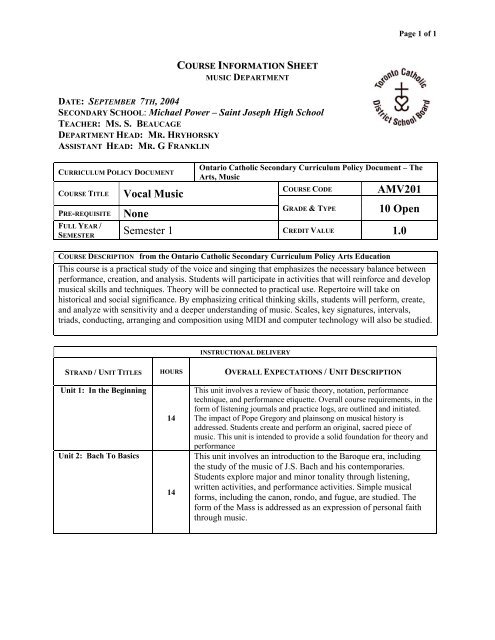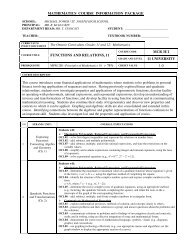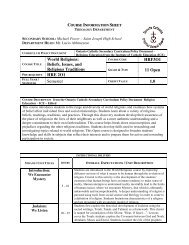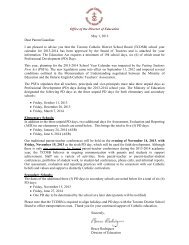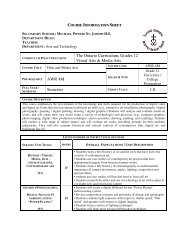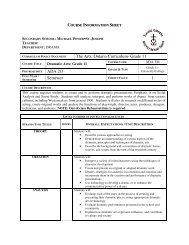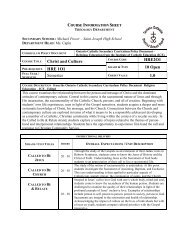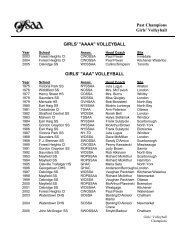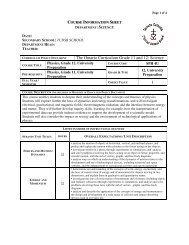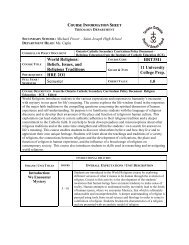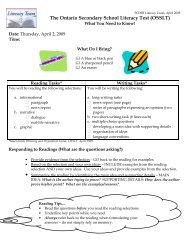COURSE INFORMATION SHEET - MPSJ.ca
COURSE INFORMATION SHEET - MPSJ.ca
COURSE INFORMATION SHEET - MPSJ.ca
Create successful ePaper yourself
Turn your PDF publications into a flip-book with our unique Google optimized e-Paper software.
Page 1 of 1<strong>COURSE</strong> <strong>INFORMATION</strong> <strong>SHEET</strong>MUSIC DEPARTMENTDATE: SEPTEMBER 7TH, 2004SECONDARY SCHOOL: Michael Power – Saint Joseph High SchoolTEACHER: MS. S. BEAUCAGEDEPARTMENT HEAD: MR. HRYHORSKYASSISTANT HEAD: MR. G FRANKLINCURRICULUM POLICY DOCUMENT<strong>COURSE</strong> TITLEPRE-REQUISITEVo<strong>ca</strong>l MusicNoneOntario Catholic Secondary Curriculum Policy Document – TheArts, Music<strong>COURSE</strong> CODEGRADE & TYPEAMV20110 OpenFULL YEAR /SEMESTERSemester 1 CREDIT VALUE 1.0<strong>COURSE</strong> DESCRIPTION from the Ontario Catholic Secondary Curriculum Policy Arts Edu<strong>ca</strong>tionThis course is a practi<strong>ca</strong>l study of the voice and singing that emphasizes the necessary balance betweenperformance, creation, and analysis. Students will participate in activities that will reinforce and developmusi<strong>ca</strong>l skills and techniques. Theory will be connected to practi<strong>ca</strong>l use. Repertoire will take onhistori<strong>ca</strong>l and social signifi<strong>ca</strong>nce. By emphasizing criti<strong>ca</strong>l thinking skills, students will perform, create,and analyze with sensitivity and a deeper understanding of music. S<strong>ca</strong>les, key signatures, intervals,triads, conducting, arranging and composition using MIDI and computer technology will also be studied.INSTRUCTIONAL DELIVERYSTRAND / UNIT TITLES HOURS OVERALL EXPECTATIONS / UNIT DESCRIPTIONUnit 1: In the BeginningUnit 2: Bach To Basics1414This unit involves a review of basic theory, notation, performancetechnique, and performance etiquette. Overall course requirements, in theform of listening journals and practice logs, are outlined and initiated.The impact of Pope Gregory and plainsong on musi<strong>ca</strong>l history isaddressed. Students create and perform an original, sacred piece ofmusic. This unit is intended to provide a solid foundation for theory andperformanceThis unit involves an introduction to the Baroque era, includingthe study of the music of J.S. Bach and his contemporaries.Students explore major and minor tonality through listening,written activities, and performance activities. Simple musi<strong>ca</strong>lforms, including the <strong>ca</strong>non, rondo, and fugue, are studied. Theform of the Mass is addressed as an expression of personal faiththrough music.
Page 2 of 2UNIT 3: CLASSICALLYMINDED20The Classi<strong>ca</strong>l period is introduced through a juxtaposition of the life ofMozart on the strong formal conventions of the period. The study ofintervals and triads form the foundation for the analysis and compositionof theme and variations. This unit concludes with a look at Beethovenand his music and the transition between Classi<strong>ca</strong>l and Romantic eras.Students are introduced to sonata allegro form.UNIT 4: GET WITH THEPROGRAM20Program music of the Romantic era provides a framework for students tocreate their own musi<strong>ca</strong>l story. Emphasis will be placed on the telling ofour story as a Christian community through music. The unit culminatesin the celebration of a liturgy. This unit is intended to provide thestudents with a deeper understanding of the signifi<strong>ca</strong>nce of music withinthe liturgyUNIT 5: EVERYTHINGGOES14This unit introduces students to the concepts of twentieth centuryart music with a focus on Canadian composers. Students willcreate and perform a sounds<strong>ca</strong>pe including natural, artificial, andfound sounds.UNIT 6: GROOVY14Students will be introduced to twentieth century commercial musicthrough a review of the musi<strong>ca</strong>l contributions of Duke Ellington, JohnLennon and Paul McCartney, and David Foster. Topics included are theevolution of jazz, the impact of technology on music, and live versusrecorded music. This unit will bring students to the musi<strong>ca</strong>l present,which will then be developed and extended in the subsequent and finalunit. Students will complete and submit an independent study on aCanadian musi<strong>ca</strong>l artistUNIT 7: THE STATE OFTHE ART14This unit focuses on music in society. There is a dual emphasis onmusic as a <strong>ca</strong>reer opportunity and the employability of the musicstudent in the world of work. Students will look at the use ofmusic and related technology in advertising, and marketing as wellas music’s function as a commodity. The intent of this unit is toprovide the students with the opportunity to demonstrate theiraccumulated knowledge and skills in the planning, performing,managing, and marketing of a musi<strong>ca</strong>l event.
Page 3 of 3STUDENT EVALUATION CRITERIATERM – 70% FINAL – 30%10 ≤ RELATIVE EMPHASIS / WEIGHTING ≤ 40 RELATIVE EMPHASIS / WEIGHTINGKNOWLEDGE/UNDERSTANDING(INCLUDING: THEORY TESTS AND ASSIGNMENTS)15 Exam 10INQUIRY/THINKING15 Performance 15(Including: Journals, analysis etcCOMMUNICATIONEar training and(INCLUDING PERFORMANCE AND PRESENTATION) 155analysisAPPLICATION25(INCLUDING: SOLO AND ENSEMBLE PERFORMANCE)TERM TOTAL 70 FINAL TOTAL 30FINAL REPORT CARD GRADECALCULATION – 100%TERM TOTAL + FINAL TOTAL= REPORT CARD MARKASSESSMENT FORMAT USEDWRITTEN PERFORMANCE OTHERTheory assignments Teacher Observation Melody creating Short answers Solo/ensemble playing Student-teachertestsconferencesUnit tests Skills check lists Guest speakers Journals Peer Assessment Audio-visual presentation Analysis Self Assessment Midi Assignment Papers/reportsRESOURCESTEXTBOOK SSTUDENT MATERIALSEXCURSIONSVarious repertoire, theory worksheets, analysis forms3-ring binder, pencil, eraserTBA
Page 4 of 4Student Assessment and Evaluation PolicyPolicyPlagiarism • As a community our goal is tocreate an environment whereintellectual integrity anda<strong>ca</strong>demic honesty prevails• The Ministry of Edu<strong>ca</strong>tionsuggests each schoolcommunity create its ownpolicyReportingDates• Information dealing withstudent performance is to beavailable in a timely manner• Formal reporting dates are setat the start of the school yearExtra Help • Additional help is available forstudentsProcedure• Students are instructed in class thatplagiarism is the presentation ofsomeone else’s work as their own• Students are instructed as to thedifferent forms of plagiarism• Students sign a contract outliningthat they understand the meaning ofplagiarism and promise to honourthe goals of intellectual integrity• Students are in-serviced in ourlibrary concerning different forms ofreferencing material• The plagiarism policy is publishedin the school agenda book• Plagiarism may result in a mark ofzero at <strong>MPSJ</strong>• Early warning letters for students atrisk of being unsuccessful are sentout early in the semester• Mid term report• Final reports• Reports on successful completion ofOSSLT, community service• Students <strong>ca</strong>n arrange to meet withtheir classroom teacher outside ofclassroom hours• Students <strong>ca</strong>n meet with guidancecounselor to arrange for tutoring• IB students are available to helpstudentsTeacherContacts• Staff are available for contactin a variety of methods• Teachers view contact with thehome as key building block toa<strong>ca</strong>demic successHomework • Homework is key componentto student learning• Students regularly receivehomework in all subjects• Homework is meant to containnumerous and variedopportunities to learn• Homework is to be assessedAbsences • Absences need to be reportedto the attendance office intimely manner• Teachers <strong>ca</strong>n be contacted viavoicemail or through a <strong>ca</strong>ll made tothe Main Office or Guidance Office• Teachers communi<strong>ca</strong>te throughParent-Teacher interviews, earlywarning letters, mid-term marks,final marks, and arrangedappointments• Homework is assessed as a learningskill using a variety of assessmentinstruments, including checklists,oral re<strong>ca</strong>ll, and classroom spotcheck• When homework is not regularlycompleted or done poorly the homeis contacted• When a student is returning from anabsence the teacher requires anexplanation, usually a note or phone
Page 5 of 5• The home needs to contact theschool if a student is to beabsent• When a student is absent fromschool it is the student’sresponsibility in concert withthe teacher to make up thework and demonstrate theyhave met the courses’expectations• If a student is chroni<strong>ca</strong>llyabsent from school they maynot receive a credit<strong>ca</strong>ll from home• When a student has been absentfrom school the teacher will provideremediation• If a student has been found to havebeen absent without reason, a markof zero may be assessed forincomplete work – furthermore, thestudent may receive communityservice or suspension from schoolfor skipping a classMissed Work • Work that is an integral part ofthe courses’ expectations mustbe completed• Students must takeresponsibility for work that hasbeen missed• “Missed and incompleteassignments do impact on thestudent’s grade” (policy topractice, frequently askedquestions, pg. 20)• Student-Teacher conference todetermine why work was missed• Students are responsible to <strong>ca</strong>tch upon missed work as expeditiously aspossible - this <strong>ca</strong>n be done throughcontacting the teacher, having abuddy in class keep the student up todate, or by checking teacher web site(if available)• A reasonable timeline should becreated for student to completemissed workLateAssignments• Late assignments are reportedin the learning skills section ofthe evaluation• Assignments must besubmitted in a timely manner• The student will be madeaware of key dates forcompleting assignments andshould plan his or her timeaccordingly• Deducting of marks forlateness as per timeline• Student –Teacher conference todetermine why assignment is late• A 10% deduction will be imposedon students who submit anassignment beyond the due date• Assignments will not be acceptedbeyond a one-week late submissiontimeline• Parent will be contacted by theteacher if the student persists inhanding in late work
Page 6 of 6LEARNING SKILLS CRITERIAIN EACH REPORTING PERIOD, REPORT ON THE QUALITY OF THE LEARNING SKILLS DEMONSTRATED BY THESTUDENT IN EACH OF THE CATEGORIES IDENTIFIED ON THE REPORT CARD USING THE FOLLOWING LETTERSYMBOLS.E–EXCELLENT G–GOOD S–SATISFACTORY N–NEEDS IMPROVEMENTSKILL: WORKS INDEPENDENTLYINDICATORS:• accomplishes tasks independently• accepts responsibility for completing tasks• follows instructions• regularly completes assignments on time and with <strong>ca</strong>re• demonstrates self-direction in learning• independently selects, evaluates, and uses appropriatelearning materials, resources, and activities• organizes work when faced with a number of tasks• devises and follows a coherent plan to complete a task• follows specific steps to reach goals or to makeimprovements• revises steps and strategies when necessary to achieve a goal• seeks out new opportunities for learning• responds to challenges and takes risks• demonstrates interest and curiosity about concepts, objects,events, and resources• seeks necessary and additional information in print,electronic, and media resources• identifies problems to solve, conducts investigations, andgenerates questions for further inquiry• requires little prompting to complete a task, displaying selfmotivationand self-direction• works willingly and cooperatively with others• shares resources, materials, and equipment with others• responds and is sensitive to the needs and welfare of others• solves problems collaboratively• accepts various roles, including leadership roles• takes responsibility for his or her own share of the work to bedone• works to help achieve the goals of the group or the class• helps to motivate others, encouraging them to participate• contributes information and ideas to solve problems andmake decisions• completes homework on time and with <strong>ca</strong>re• puts forth consistent effort• follows directions• shows attention to detail• uses materials and equipment effectivelySKILL: ORGANIZATIONINDICATORS:SKILL: INITIATIVEINDICATORS:• demonstrates persistence in bringing tasks to completion• uses time effectively• uses prior knowledge and experience to solve problems andmake decisions• reflects on learning experiences• manages and uses time effectively and creatively• demonstrates ability to organize and manage information• follows an effective process for inquiry and research• uses appropriate information technologies to organizeinformation and tasks• approaches new learning situations with confidence and apositive attitude• develops original ideas and devises innovative procedures• attempts a variety of learning activities• seeks assistance when needed• uses information technologies in creative ways to improvelearning for self or othersSKILL: TEAMWORKINDICATORS:• questions the ideas of the group to seek clarifi<strong>ca</strong>tion, testthinking, or reach agreement• shows respect for the ideas and opinions of others in thegroup or class• listens attentively, without interrupting• in discussions, paraphrases points of view and asks questionsto clarify meaning and promote understanding• recognizes the contribution of group members by means ofencouragement, support, or praise• seeks consensus and negotiates agreement before makingdecisionsSKILL: WORK HABITS/HOMEWORKINDICATORS:• begins work promptly and uses time effectively• perseveres with complex projects that require sustained effort• applies effective study practicesNOTE: The above chart is a reformatting of the skills identified in the Ministry of Edu<strong>ca</strong>tion’s Guide to theProvincial Report Card, Grades 9 – 12 : Appendix C: pages 27 to 29 .


